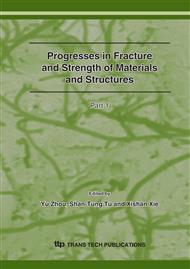p.1633
p.1637
p.1641
p.1645
p.1649
p.1653
p.1657
p.1663
p.1667
Tensile Properties and Fatigue Strength of Ultrafine Grained Pure Copper
Abstract:
Oxygen-free copper was processed by equal channel angular pressing with different numbers of ECAP process cycles, NP. Tensile strength was increased with an increase in NP, but it tended to saturate after NP = 4. Conversely, elongation was dramatically decreased by first pressing, but it tended to saturate up to NP = 3, followed by slight increasing trend after NP = 4. Fatigue tests of specimens processed with NP = 4 and 8 were performed. The change in surface morphologies during fatigue was monitored successively. In addition to this, the change in surface hardness was measured. Significant decrease in surface hardness due to cyclic stresses was measured. The physical basis of fatigue damage of UFG copper was discussed based on the experimental results.
Info:
Periodical:
Pages:
1649-1652
Citation:
Online since:
September 2007
Authors:
Price:
Сopyright:
© 2007 Trans Tech Publications Ltd. All Rights Reserved
Share:
Citation:


